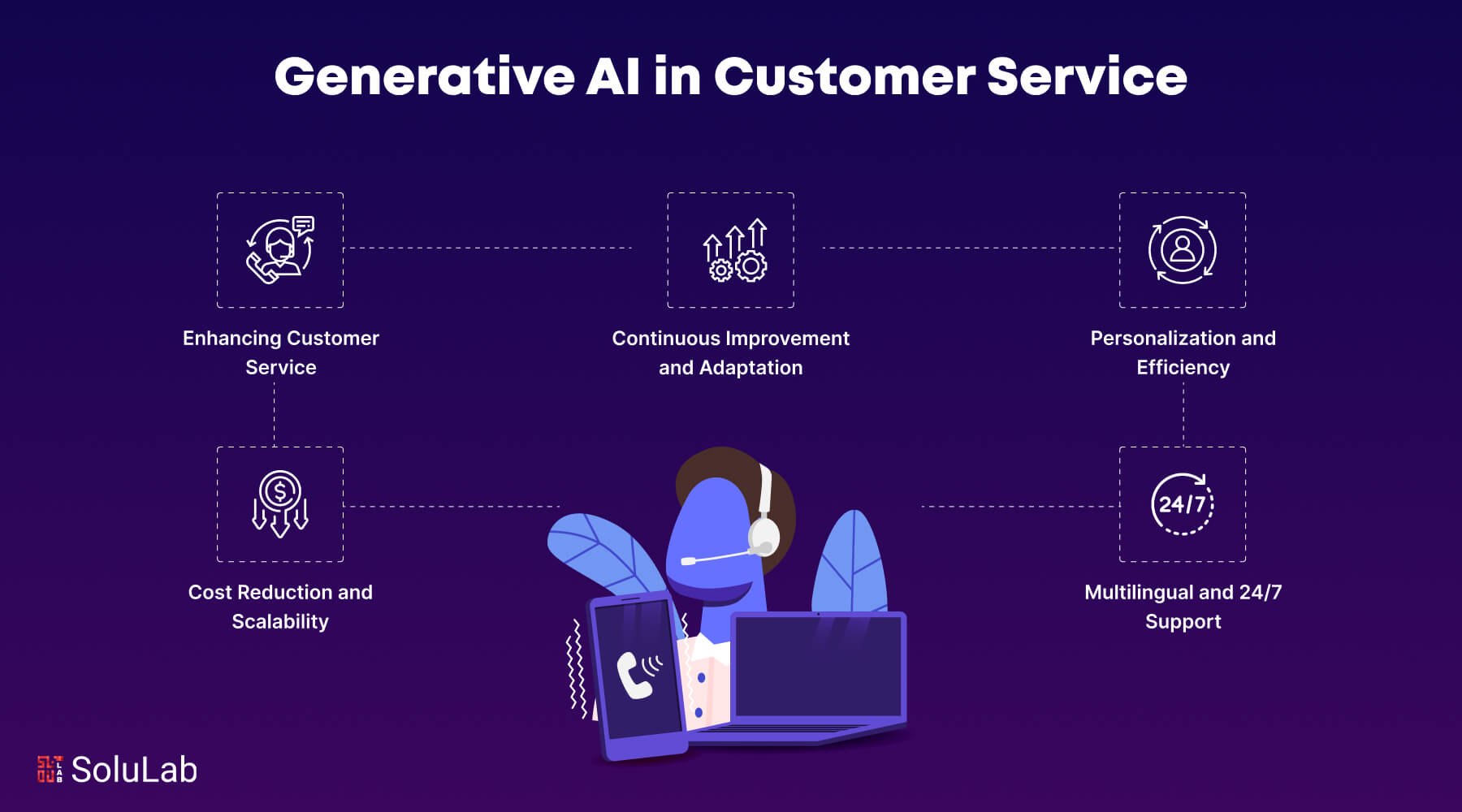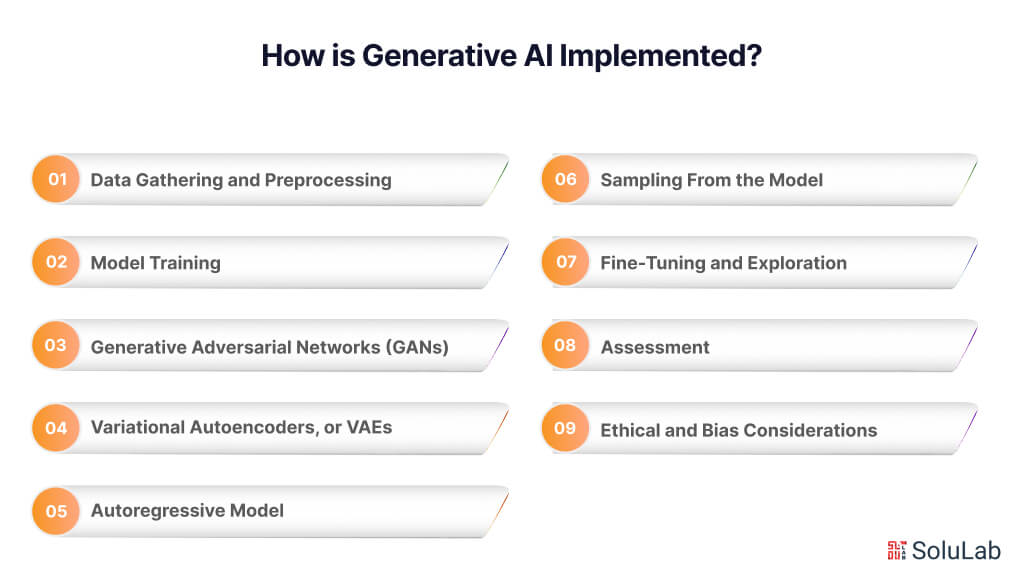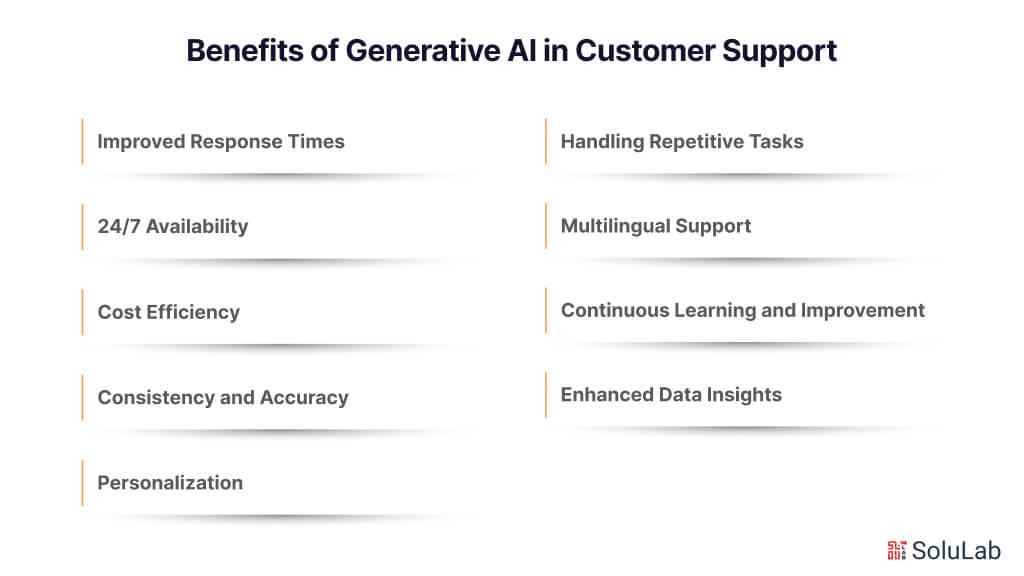
Customer service has suddenly risen up the corporate ladder and is now a major management focus, due to generative AI. In fact, according to 85% of executives, in the next two years, generative AI will be used for direct customer communication. As a result, 63% anticipate investing in generative AI use cases for their agents by the end of 2023.
According to a Gartner research study, genAI’s capacity to give timely, accurate, and personalized responses increases customer satisfaction by 33% when compared to traditional customer support approaches.
If you want to know how generative AI for customer support can help and deliver the ROI that leadership seeks, this blog will help you with all that you need to know! Let’s start with the basics first.
What is Generative AI?
Generative AI is a branch of artificial intelligence that produces new outputs, data, or content. Generative AI systems employ data that already exists to identify patterns, evaluate those patterns, and generate outputs that mimic material created by humans. These outputs can include writing, images, music creation, and more.
Although generative AI may appear like a dazzling new technology given the recent excitement around it, its roots may be found in the 1950s and 1960s. Nevertheless, generative AI applications weren’t genuinely able to produce original content outputs until 2014, when generative adversarial networks (GANs), a particular kind of machine learning, were introduced.
Artificial Intelligence vs Generative Artificial Intelligence
AI is a general word that is frequently used to refer to a variety of advanced computer systems. Although they are linked, artificial intelligence and generative AI are two different things within the larger subject of artificial intelligence. Large language models (LLMs), generative AI, machine learning, and artificial intelligence (AI) are sometimes used interchangeably, therefore it’s critical to understand the distinctions. Let’s first clarify what AI and generative AI are not.
The term artificial intelligence (AI) refers to the larger field of computer sciences that aims to create intelligent machines capable of carrying out tasks that would normally be completed by humans. Artificial intelligence is capable of recognizing speech, solving problems, perceiving, and comprehending language. Artificial Intelligence in customer services encompasses a vast array of methodologies, such as machine learning, natural language processing, and expert systems. AI can recognize data and reply to what it sees. However, this is limited to its function.
However, generative AI goes one step further by using data to produce wholly original content in a variety of formats. Generative AI creates fresh material by using machine learning models to identify patterns in preexisting data.
Both AI and generative AI in customer service continue to grow and change. Let’s now discuss a few more terminology related to generative AI that you have probably seen used.
Machine learning is a subject or methodology within AI research. In order to help computer systems gain insight into data and make predictions or judgments, algorithms, and models must be developed. Without being specifically programmed to do so, machine learning systems can improve their performance over time by learning from examples and making adjustments in response to the data they are exposed to.
Large language models (LLMs) are the newest and least-defined idea. A machine learning model that is trained on a vast volume of text that focuses on text generation and understanding to produce responses that sound realistic is called a large language model, such as OpenAI’s GPT-3.
How is Generative AI Implemented?

Generative AI creates new content that is comparable to the old data it has been educated on by using machine learning to identify typical trends and arrangements in massive amounts of data. Generative AI gets more complex the more examples or data it has to work with.
A brief synopsis of the generative AI technique is provided below:
- Data Gathering and Preprocessing: Text, pictures, or any other kind of data that the model is supposed to produce is gathered into a dataset. Preprocessing is done on this data to guarantee correctness and consistency.
- Model Training: There are numerous models used in generative AI, selected according to the characteristics of the data and the intended kind of content development. The most frequent models include:
- Generative Adversarial Networks (GANs): These are a type of machine learning model in which two neural networks receive training concurrently to learn from and interact with one another in order to improve prediction accuracy.
- Variational Autoencoders, or VAEs: These are artificial intelligence (AI) algorithms that can both encode and decode data. It divides up big data sets into smaller groups or representations in order to accomplish this. The term “latent space” refers to these smaller representations. The original data is concealed in the latent space’s compressed representation, enabling the VAE to decode—that is, rebuild an image, for example—by seeing the latent space.
- Autoregressive Model: Based on historical behavior data, autoregressive models are utilized in machine learning to forecast future behavior.
- Sampling From the Model: You can use the model to create new content as soon as it has been trained. When you give the model a random input or seed, it will apply the patterns it has learned to create new data with features similar to the training set.
- Fine-Tuning and Exploration: You may want to modify the model’s parameters to alter the generated content’s quality or style, depending on the application. By playing with different inputs, changing parameters, and examining the resultant outputs, you can investigate the capabilities of the model.
- Assessment: Consider a range of factors while evaluating the produced material, including realism, coherence, relevancy, and aesthetics. Iteratively refine the model in light of user input and assessment outcomes.
- Ethical and Bias Considerations: Recognize the possibility of ethical issues with bias, false information, and possible abuse of the produced content. Take action to allay these worries and make sure generative AI is used responsibly.
Why is Generative AI Important for Customer Service?
Generative AI for customer service has become a significant technological advancement with wide-ranging implications across various industries. One area where it is particularly impactful is in customer service. The integration of generative AI models in customer service is transforming how businesses interact with their customers, offering numerous benefits that enhance efficiency, personalization, and overall customer satisfaction.
1. Enhancing Customer Service
Customer Service AI tools leverage advanced machine learning algorithms to understand and respond to customer queries. These tools can handle a variety of tasks, from answering frequently asked questions to managing complex support tickets. The ability of AI to process and analyze vast amounts of data quickly allows for immediate, accurate responses, reducing wait times and improving the customer experience.
2. Personalization and Efficiency
AI in customer service can tailor interactions based on individual customer preferences and past interactions. By analyzing previous queries and behavior, generative AI models can predict customer needs and provide personalized recommendations. This level of personalization fosters a stronger connection between the business and the customer, leading to increased satisfaction and loyalty. Moreover, AI for customer services automates routine tasks, freeing up human agents to focus on more complex and nuanced issues. This not only improves the efficiency of the support team but also ensures that customers receive prompt and effective assistance.
3. Cost Reduction and Scalability
Implementing artificial intelligence in customer services significantly reduces operational costs. Automated systems can handle a large volume of inquiries simultaneously, eliminating the need for a proportionate increase in staff as the customer base grows. This scalability is particularly beneficial for businesses experiencing rapid growth or those with fluctuating demand.
4. Continuous Improvement and Adaptation
Generative AI models are designed to learn and improve over time. As they interact with customers, they gather data and refine their algorithms, becoming more adept at understanding and addressing various issues. This continuous improvement ensures that customer service AI tools remain effective and relevant, adapting to new trends and customer expectations.
5. Multilingual and 24/7 Support
Another crucial advantage of artificial intelligence and customer service is the ability to provide support in multiple languages and around the clock. This capability is essential for global businesses that need to cater to customers in different time zones and languages. Generative AI models can seamlessly switch between languages and provide consistent support, ensuring that all customers receive high-quality service regardless of their location or language.
What Effects Does Generative AI Have on Customer Support?
There are speculations that artificial intelligence (AI) is going to drastically alter how we conduct business. It already has in terms of customer service. The global chatbot industry is anticipated to grow to $994 million by 2024.
Like earlier incarnations of AI, generative AI will undoubtedly replace certain customer support responsibilities, but it’s also creating new opportunities. Generative AI will increase the value of human input rather than lessen it, according to customer service experts.
Most customer service concerns are automatically resolved with the smallest amount of human effort whenever generative AI and customer service teams collaborate well. Additionally, it’s providing customer support workers with the chance to advance in their careers—from customer support champion to bot manager, or from customer service agent to conversational AI specialist.
Here’s how to make the switch to AI-first and make sure AI develops over time in tandem with the resources and staff reorganization of your customer support department:
Phase 1: Deploy
Generative AI Using pre-existing information and support documentation scraping, it may generate and provide solutions to client inquiries without the need for human training. As a result, staff members can now concentrate on finding more automation opportunities, creating action flows, optimizing, and inspecting transcripts, rather than spending weeks developing conversational AI systems for customer support teams. This implies that anyone can construct automation or bots without having any technological experience. As an alternative, decide which agent is performing the best and promote them to Bot Specialist. Give the Bot Specialist the resources they need to advance in their career by setting Automated Customer Experience (ACX) benchmarks and KPIs, as well as training and deploying the AI chatbot across service channels.
Make sure you have your plan, people, and technology in place to assure success in this initial period. This appears to be:
People: Develop and deploy the chatbot, as well as gain knowledge from the partner’s suggestions for optimal practices and generative AI experience. Hire the Bot Specialists and present them to the larger customer service business as the AI chatbot partner.
- A customer service manager, to whom they will provide reports regarding the deployment of AI chatbots and content management
- One of the main stakeholders in the database of content management is the education team.
- The engineering and product teams for the website’s integrations and chatbot embedding
Technology: Link an agent system and an educational tool to the generative AI chatbot.
Strategy: The application of generative AI requires a solid, well-defined plan. The following actions should be taken by a bot specialist:
- Verify that the documentation in the knowledge base is correct, current, and tailored for generative AI.
- Establish weekly check-ins with the team of educators to identify any possibilities or content gaps in the transcripts of chatbots.
- Establish quarterly objectives for customer service. OKRs
- Report on a regular basis regarding the objectives to their manager.
Phase 2: Learn
After completing the basic setup and getting the AI chatbot operational, it’s critical to begin monitoring the bot’s metrics and insights. Put more effort into developing deeper integrations that enable more automated resolutions and powerful actions.
In addition, a worker in a Bot Specialist position may be promoted to a Bot Manager position or collaborate with one as generative AI not only writes material but also helps refine and produce variations of it. The AI chatbot and content optimization will remain the Bot Manager’s primary priorities. Their time will be better spent creating more valuable automation flows and making sure all content is branded consistently.
Together with reporting customer issues and trends, bot managers should collaborate with the product, engineering, and education teams to suggest ways to make improvements. Additionally, they will manage the CRM connectors and use API endpoints to link the generative AI chatbot to any required software.
The Bot Manager’s objective is to set up chat as the main support channel. To help achieve this, they must disseminate AI insights throughout the organization to encourage other teams to consider how they can use this data and become AI-first as well.
Phase 3: Improve
The Director of ACX will be spearheading the third phase, coordinating with executives throughout the organization and advocating for the client to have an impact on crucial business choices. They will go further into the AI chatbot approach, making sure that it makes use of machine learning, and that the group is incorporating AI guidance and extending AI capabilities in the context of customer care.
The Director of ACX will collaborate across functional lines to provide business development teams with customer insights, manage the design and execution of new support program projects, and create a long-term mechanization roadmap. However, AI is automating difficult use cases and dynamically exploiting customer data to make decisions, all the while they’re boosting the role of the customer service department within the company and concentrating on high-level KPIs.
Benefits of Generative AI in Customer Support

Generative AI has revolutionized customer support by offering numerous advantages that enhance both the efficiency of support teams and the overall customer experience. Here are some key benefits of implementing generative AI in customer support:
1. Improved Response Times
One of the most significant benefits of generative AI in customer support is its ability to provide instant responses to customer queries. Unlike human agents, AI-powered systems can handle multiple inquiries simultaneously without delays. This leads to significantly reduced response times, ensuring that customers receive the help they need promptly.
2. 24/7 Availability
Generative AI enables round-the-clock customer support, making it possible for businesses to assist customers at any time of day or night. This 24/7 availability is particularly beneficial for global businesses with customers in different time zones, ensuring that support is always accessible.
3. Cost Efficiency
Automating customer support with AI reduces the need for large support teams, leading to significant cost savings. Businesses can handle a higher volume of inquiries without a corresponding increase in staffing costs. Additionally, AI systems can scale effortlessly to meet increased demand during peak times without incurring additional expenses.
4. Consistency and Accuracy
Generative AI ensures consistent and accurate responses to customer inquiries. Unlike human agents, who may vary in their responses and make occasional errors, AI systems provide standardized and precise answers based on extensive data and pre-defined protocols. This consistency improves the reliability and quality of customer support.
5. Personalization
Generative AI can analyze customer data to deliver personalized responses and recommendations. By understanding customer preferences, history, and behavior, AI systems can tailor interactions to meet individual needs. This personalization enhances the customer experience, fostering stronger relationships and increasing satisfaction.
6. Handling Repetitive Tasks
AI systems excel at managing repetitive and mundane tasks, such as answering frequently asked questions or processing standard requests. By automating these tasks, human agents are freed up to focus on more complex and nuanced issues that require human judgment and empathy. This improves the overall efficiency and effectiveness of the support team.
7. Multilingual Support
Generative AI can provide support in multiple languages, breaking down language barriers and ensuring that customers worldwide receive high-quality service. AI models can seamlessly switch between languages, offering accurate and consistent support to non-native speakers, which is crucial for global businesses.
8. Continuous Learning and Improvement
Generative AI systems continually learn and improve from interactions with customers. They use machine learning algorithms to refine their responses and adapt to new situations over time. This continuous improvement ensures that the AI remains up-to-date with evolving customer needs and industry trends, enhancing its effectiveness.
9. Enhanced Data Insights
AI-powered customer support systems generate valuable data insights. By analyzing interactions, businesses can gain a deeper understanding of customer behavior, preferences, and pain points. These insights can inform strategic decisions, improve products and services, and drive overall business growth.
Generative AI Customer Services Use Cases
Generative AI is being adopted across various sectors to enhance customer service operations, streamline processes, and improve customer satisfaction. Here are some prominent generative AI use cases in customer service:
1. Automated Customer Support: Generative AI use cases in automated customer support involve deploying AI-powered chatbots and virtual assistants to handle routine inquiries. These AI systems can instantly provide accurate answers to frequently asked questions, process orders, and troubleshoot common issues, reducing the workload on human agents and ensuring customers receive prompt responses.
2. Personalized Recommendations: Generative AI can analyze customer data to offer personalized product or service recommendations. By understanding individual preferences, purchase history, and browsing behavior, AI systems can suggest relevant products or services, enhancing the customer experience and boosting sales. This level of personalization builds stronger customer relationships and increases loyalty.
3. Dynamic Content Generation: Generative AI can create dynamic content tailored to specific customer needs. For example, in e-commerce, AI can generate personalized marketing emails, product descriptions, and promotional messages. This ensures that the content resonates with the target audience, leading to higher engagement rates and improved conversion rates.
4. Proactive Customer Engagement: AI systems can monitor customer interactions and identify patterns that indicate potential issues. By proactively reaching out to customers experiencing problems or delays, businesses can address concerns before they escalate. This proactive approach improves customer satisfaction and reduces churn rates.
5. Sentiment Analysis and Feedback Management: Generative AI can analyze customer feedback from various channels, including social media, reviews, and surveys. By understanding the sentiment behind customer comments, businesses can gain insights into customer satisfaction and identify areas for improvement. AI can also generate responses to feedback, demonstrating that the company values customer opinions.
6. Virtual Agents for Complex Queries: While AI excels at handling routine tasks, it can also assist with more complex customer inquiries. Virtual agents powered by generative AI can guide customers through intricate processes, such as troubleshooting technical issues or navigating financial transactions. These agents can escalate queries to human agents when necessary, ensuring seamless support.
7. Fraud Detection and Prevention: In industries like banking and e-commerce, generative AI can detect fraudulent activities by analyzing transaction patterns and identifying anomalies. By flagging suspicious behavior in real time, AI systems help prevent fraud and protect both the business and its customers.
8. Supply Chain Optimization: Generative AI supply chain applications can significantly enhance customer service by optimizing inventory management, forecasting demand, and streamlining logistics. AI can predict product demand trends, ensuring that popular items are always in stock and reducing the likelihood of delays. This leads to more efficient operations and higher customer satisfaction.
Conclusion
In conclusion, the transformative power of generative AI is revolutionizing customer service technology. By using advanced natural language processing and machine learning algorithms, businesses can provide more personalized, efficient, and accurate support to their customers. This shift not only enhances customer satisfaction but also optimizes operational efficiency, reducing response times and freeing up human agents for more complex tasks. As generative AI continues to evolve, its integration into customer service promises to further refine and elevate the customer experience, setting a new standard for what customers can expect from service interactions.
However, the journey to seamless generative AI implementation in customer service is not without challenges. Issues such as ensuring data privacy, managing the complexity of AI training, and integrating AI solutions with existing systems can pose significant hurdles. Additionally, there are concerns about maintaining the human touch in customer interactions and preventing AI from producing inaccurate or biased responses. SoluLab, with its expertise in developing and deploying AI solutions, is poised to address these challenges effectively. By providing tailored, secure, and scalable AI solutions, SoluLab can help businesses navigate the complexities of AI adoption, ensuring a smooth and successful integration that enhances customer service. To learn more about how SoluLab can transform your customer service with innovative AI technology, contact us today.
FAQs
1. How does generative AI improve the customer service experience?
Generative AI enhances customer service by providing more personalized and efficient interactions. It uses advanced natural language processing to understand and respond to customer queries accurately and quickly. This technology can handle a wide range of customer requests, reducing response times and freeing human agents to focus on more complex issues, ultimately leading to higher customer satisfaction and more streamlined service operations.
2. What are the main benefits of using generative AI in customer service?
The main benefits include improved response times, enhanced personalization, increased operational efficiency, and consistent service quality. Generative AI can handle large volumes of queries simultaneously, ensuring customers receive prompt assistance. It also learns from interactions to provide more accurate and tailored responses, which helps in building stronger customer relationships.
3. What challenges do businesses face when implementing generative AI in customer service?
Businesses often encounter challenges such as ensuring data privacy, managing the complexity of AI training, integrating AI with existing systems, and maintaining the human touch in customer interactions. Additionally, there’s a need to mitigate the risk of AI generating inaccurate or biased responses. Overcoming these challenges requires careful planning, robust AI frameworks, and ongoing monitoring and adjustment of AI systems.
4. How can businesses address the challenge of maintaining the human touch with generative AI?
To maintain the human touch, businesses can use generative AI to handle routine and repetitive tasks, allowing human agents to focus on more nuanced and empathetic interactions. AI systems can also be designed to escalate more complex or sensitive issues to human agents. Training AI to understand and respect the boundaries of automated assistance versus human intervention is crucial for preserving the quality of customer relationships.
5. How can SoluLab help businesses overcome the challenges associated with generative AI in customer service?
SoluLab offers expertise in developing and deploying Generative AI solutions tailored to the specific needs of businesses. They provide secure, scalable AI systems that ensure data privacy and seamless integration with existing infrastructure. SoluLab’s solutions are designed to be user-friendly and efficient, helping businesses navigate the complexities of AI adoption. By partnering with SoluLab, businesses can effectively harness the power of generative AI to enhance their customer service experience.





